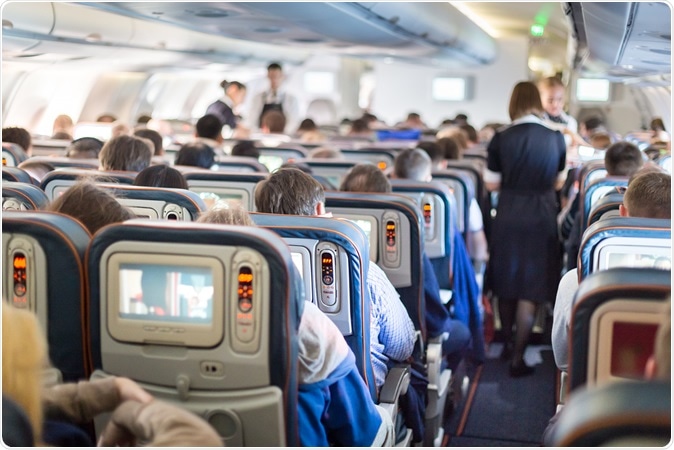Airplanes are known to be medium for spreading airborne infections mainly because of the number of people including some with contagious infections such as flu, being clubbed together in a closed space.
Research has shown that risk of getting flu is reduced if a person gets a window seat on an airplane. The study was published yesterday (19th of March 2018) in the latest issue of the peer-reviewed journal Proceedings of the National Academy of Sciences.

Image Credit: Matej Kastelic / Shutterstock
The new study shows that sitting by the window may keep a person away from the infectious people who may be on the aisle or may me moving about the flight. According to lead researcher, Vicki Stover Hertzberg of Emory University in Atlanta, getting a window seat and not moving much during the flight is the best bet to avoid catching flu. This study was funded by Boeing Co. who did not have an influence of the final results said Hertzberg.
For this study the team of researchers moved around the world in transcontinental flights in 2012 and 2013, testing the surfaces of the cabins and its air for the viruses. They also observed how people came into contact with each other during flights. As a next step the team used mathematical models and simulations to check and see how likely it was for people to come close to an infectious person on board. They created a hypothetical infectious patient sitting on the 14th row of a single-aisle airplane for a typical 4 to 5 hours flight. They noted that from this one person, according to mathematical calculations, only one person in 150 would be infected.
How to Avoid the Flu on a Plane? Try Window Seat
They noted that around 38 percent of passengers did not leave their seats during the flight. While 13 percent left their seats at least twice, 11 percent left their seats more than two times. This means that there is a substantial amount of movement in the aisles. Most of the movement came from those sitting on aisle seats, they found. On analysis they noted that movement was most (80 percent) in aisle seats and 62 percent in the middle seats and 43 percent in the window seats respectively. In their mathematical model they noted that 11 people who were sitting closest to the infected person are at greatest risk of getting the infection. This included those sitting on his or her either sides or in front or behind him or her. The risk of giving flu to another was 0.7 additional people for an infected patient, the study found. On the other hand they also performed a simulation where a crew member was similarly infected. They noted that if that was the case, the crew member infected 4.6 persons additionally per flight.
One of the problems with this study was the limited time and number of flights covered. Of the ten flights that they looked at, only one person was coughing. The researchers further could not find any of the different cold and flu viruses on board during their study. More research and a larger sample are necessary to make comments about spread of flu on flights say experts.
According to Emory’s Howard Weiss, who is a co-author, the bottom line is to “practice good hand hygiene, keep your hands away from your face”. In addition is a person is seated at least a meter away from an infected person on flight, they are, “are unlikely to get infected by influenza during an 4 to 5 hour flight.”